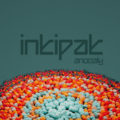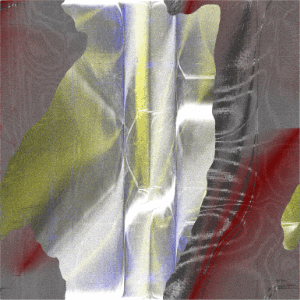Regarding Jon Mace’s background, artistic inspiration, music-making process, and any surprising insights that his followers should be aware of, it is an honor to speak with him through a series of questions and answers on behalf of Igloo Magazine.

Inducing a frisson experience
Inkipak is Jon Mace, a UK-based co-label owner and professional graphic designer, and electronic music artist. In 1990, while attending the University of Leicester to study graphic design, Jon Mace became aware of the flourishing electronic/club music scene. Inkipak‘s discography includes: releases on labels such as Fourier Transform, Wave Function, Mighty Force, Touched Music, Glawiio Music, Magnonic Signals, Distant Worlds, Móatún 7, Withhold, and Ping-discs. The sound of Inkipak is engaging, with the ability to transport listeners into the realm of absolute electronica awe. The sound that is Inkipak sustains an acidic groove layered in warm basslines, inducing a frisson experience that washes over its listener.
From my first listen to the Anomaly album, I was sold. Commendably, the proceeds from this album went to the MacMillan Cancer Support via Touched Music, making the overall impact of this album even more special. I personally got a hold of this album due to its sublime listening experience of acid basslines swirling in such a uniquely perfected flow. Anomaly is an album I was fortunate to get my hands on. From my first listen to the track “Dispepseeuh,” my jaw dropped. That beat, and the subtleties of funk and melodic transitions you cannot deny, are infectious. Heck, I could see this track being remixed into an electro track. It hasn’t happened yet, but who knows?
Jon Mace’s self-titled album, Inkipak (on Mighty Force), expertly crafts IDM tracks with alluring basslines and potent synthesizers, enabling the music to evolve effortlessly and flawlessly. The music on this album is the epitome of top-notch IDM.
It is a sheer mind-blowing experience to hear Inkipaks’s Confine EP. The self-titled track sets the stage for plentiful portions of breakbeat, acid, and IDM to satisfy your craving for stunning upbeat electronic music.
Slightly Salted (Ping-discs) was another album to be released that I was so excited about. The listening party made me feel like I was a VIP in a backstage, close-up encounter with the artist himself. Meticulous synths are saturated with superabundant basslines and plentiful percussion, which add personality to the album. The melodic progression of Inkipak’s music is flawlessly layered.
For the album Slip (Touched Music), Inkipak’s music video for the track “Climping” showcases the mind-expanding and trippy use of psychedelic images. It was an effortless experience to surrender and get lost in this track, as if it had psychoactive effects. Inkipak’s sound reflects Jon Mace’s abundance of compelling artistry and his signature sound in bass, melody, drums, and the free flow of busy beats.
The track “Out of Bounds” from the album +ve (Fourier Transform) is my favorite track on the album. The music video is another mind-bending delight that goes hand in hand with the track’s subtle funk, dripping acid, and groove-fueled beats. What is the source of this upbeat delivery of electronica goodness? Regarding Jon Mace’s background, artistic inspiration, music-making process, and any surprising insights that his followers should be aware of, it is an honor to speak with him through a series of questions and answers on behalf of Igloo Magazine.

Anne Jackson / Igloo :: The acidic grooves and beats in your music have a unique quality that certainly stands out. Many electronic music artists venture off into experimental, avant-garde, glitch, and drum n bass. You seem to maintain a cohesive pace, and we absolutely love that. Could you share with us where you find inspiration to choose this particular pace in music where you deliver acidic grooves and beats (especially on the tracks “Dispepseeuh” and “Out of Bounds”)?
Jon Mace / Inkipak :: When I set out to create a new track, once it starts coming together in loop form, I will quickly cross over to mapping it out and visually drop over all the individual elements into a very rough 5-6 min track. I’ll then start to chip away at it, like a block of stone, until it takes some sort of shape. I can’t stand getting bogged down with one piece of music as I have a very short attention span, so I often have 5 or even 10 tracks on the go which I will open periodically and tweak. I like to be able to enjoy my own music once it’s complete and that involves not over-hearing it while making it. I know perhaps this limits the ultimate level of detail and polish each one has but each track is what it is, and I like to draw the line and move on to the next one.
Each track is very much its own thing and I never set out to create any particular style, although I do get fixated on various breaks which appear in numerous tracks. In essence, my priority is to make music that I want to listen to and that’s all I can do. There’s no point making music for anyone else.
Your music has been described through a range of genres in electronic music. How would you describe the genre and/or style of the music you create? Does it change?
Inkipak :: To be honest I don’t know quite where I fit in to the scheme of things. Some of my music is DJ friendly as I used to DJ in the past, but at the same time I have a problem with just making 4/4 based tracks and sometimes like to mix things up a bit. I have no musical training so when it comes to breaking the 4/4 rule, I can get a bit random, and I imagine this is frustrating to mix with (in fact I know it is because I struggle to mix with some of my own tracks!).
I feel that with 4/4 you quickly get familiar with a track even after just one listen, but if you mess around with time signatures, ongoing listens can still bring surprises.
Since getting back into making music in 2018, I have much preferred to put albums together than EP’s. An album is a journey and can contain all sorts of material. With an EP, there is often more pressure to produce ‘similar’ sounding tracks—which are more ‘DJ friendly’ and fit in with a label’s ‘sound’. I do like to work on remixes though and over the last few years have made quite a few. I’m considering putting together a CD compilation of them at some point although many haven’t even been released yet.
When you think back to when your love of music began, who are the artists? Who are influencers in music that has developed your sound?
Inkipak :: Music has always been there even since I was very young. I’ve also had a passion for tech and got my first cassette player when I was 6 years old.
My passion for early 90s electronica takes influence from the likes of Aphex Twin, Pete Namlook, Global Communication and The Future Sound of London. These artists pushed the boundaries of modern electronica.
My influences are much wider though and include Brian Eno, Nils Frahm, The Bersarin Quartett, Jon Hopkins, My Bloody Valentine, Daniel Pemberton, Steely Dan and Talk Talk to name but a few. I may not make music in the same style, but the beauty, diversity and sheer craftsmanship of their work is an inspiration.
I like to think of my music as storytelling, taking you on a musical journey. I’m drawn to the emotive and melodic.
It is hugely important to me that I am not pigeonholed in a certain style or category. When I sit down to create music it may take any shape or form. I may use breaks and beats in many of my tracks which makes them more accessible to many, but each one has the possibility of being stripped back and expanded in a multitude of directions.
“I like to think of my music as storytelling, taking you on a musical journey.” ~ Inkipak
What do you enjoy doing outside of music?
Inkipak ::I love my family and I’m very proud of my kids. Along with my day job as a Graphic Designer, my family takes up the majority of my time (and I wouldn’t have it any other way). Making music fits into what’s left!
Describe your professional experience in graphic design and how you applied this knowledge to the promotion of your music.
Inkipak :: I’ve been involved in design since I left school and went to Epson College of Art and Design and then Leicester Polytechnic (now Leicester University). While at college I was hugely influenced by The Designers Republic and Me Company in particular. I especially like to get involved in font/logo creation and this would explain the theme/style which runs through my work, even now.
When I left college in 1991, I made some record sleeves and designs freelancing as ‘Brandnew Design’ for various small labels including Strawberry Records, Fantastic Records and The Grove Studio. Ultimately though it didn’t pay the bills and I ended up with a day job as a graphic designer for various companies over the years. I’ve always had the freelance design work running through though.
Since getting back into making music in 2018 I’ve put my own artwork together for most of my releases. I’ve also produced artwork for others too, in particular for a number of the Mighty Force releases and also for my own/jointly owned label Fourier Transform.
A leap of faith ::
What are you passionate about and how does that come through your music?
Inkipak :: It takes a leap of faith to take that big step and get your music out there. Once done, you are then open to everybody’s opinion and with social media people like to make their opinions known. As previously mentioned, I make music for myself, and ultimately, if anyone else happens to like it then that’s a bonus for me. I especially love the album release events and it’s great to get people’s reactions in the chat room as they hear new material for the first time.
In these days of musical saturation, with so much new music coming out by so, so many people every day, it is hugely gratifying to even be noticed at all. I have had such lovely feedback from many and this for me is a major driving force in keeping the passion fueled for continuing to make and release my music.
As someone who is also a music enthusiast, I am always fascinated by how artists like you can create acid-infused electronica. As far as gear, what are your favorite kinds, and how does it mesh with your creative process in the sounds you are known to create?
Inkipak :: In the 90’s I had various bits of kit and sequenced them on an old PC running Cakewalk 3, and to be honest it was always a pain to revisit tracks which were partially complete. Skipping to 2018, I chose to exclusively use software to make my music and I love it. Don’t get me wrong, I would love a room full of gear, but I imagine I would spend most of my time fiddling with it and my productivity would go out of the window. Ableton enables me to quickly and efficiently create concepts and loops which in turn become tracks, and as a bonus, every time I return to them, they are just as I left them!
Can we anticipate any forthcoming collaborations or new releases from Inkipak?
Inkipak :: I have been relatively quiet since the release of Slip last year on Touched Music. I lost my father last April to Dementia and have stepped back from it all for the last 6 months or so to take stock. I do though, have a new track/remix included on the CD release of Exalt Records The End which is coming out very soon. I also have a new album which I had planned to self-release in the latter part of 2023 on Inkitrax, but it never quite happened… this will happen very soon. I promise. I’m also very excited about a possible collaboration with Brian Dougans from FSOL although it’s very early days on that one. I also (always) have a number of projects on the go for Fourier Transform.
Who knows what this year will bring? Stay tuned, and thanks for all your support!




















![Extrawelt :: AE-13 (Adepta Editions) — [concise]](https://igloomag.com/wp/wp-content/uploads/2025/04/extrawelt-ae-13_v_feat-75x75.jpg)
![Beyond the Black Hole :: Protonic Flux EP (Nebleena) — [concise]](https://igloomag.com/wp/wp-content/uploads/2025/04/beyond-the-black-hole-protonic-flux_feat-75x75.jpg)
![H. Ruine, Mikhail Kireev :: Imagined / Awakenings (Mestnost) — [concise]](https://igloomag.com/wp/wp-content/uploads/2025/04/h-ruine-mikhail-kireev-imagined-awakenings_feat2-75x75.jpg)


![Squaric :: 808 [Remixes] (Diffuse Reality) — [concise]](https://igloomag.com/wp/wp-content/uploads/2025/04/squaric-808-remixes_feat-75x75.jpg)


